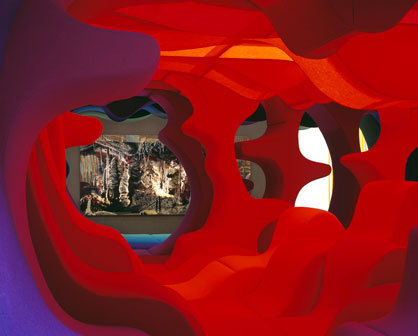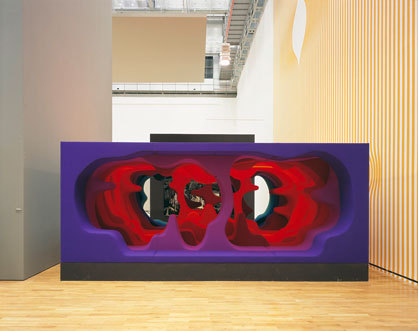Interieur / Exterieur
Text by NoéMie Schwaller
Zürich, Switzerland
24.03.09
Nya Nordiska, a leading international textile company based in Dannenberg, North Germany, whose early stages were strongly influenced by Scandinavian design, recently received a highly unusual enquiry from the Kunstmuseum Wolfsburg.
Nya Nordiska, a leading international textile company based in Dannenberg, North Germany, whose early stages were strongly influenced by Scandinavian design, recently received a highly unusual enquiry from the Kunstmuseum Wolfsburg. The legendary interior landscape “Fantasy Landscape“ by the designer Verner Panton was to be returned to its original condition for the museum's exhibition “Interieur/ Exterieur - Wohnen in der Kunst“ (Interior/exterior – living with art).
Verner Panton, Phantasy Landscape Visiona 2, 1970, Kunstmuseum Wolfsburg, © Panton Design, Basel, Photo: Matthias Langer

Verner Panton, Phantasy Landscape Visiona 2, 1970, Kunstmuseum Wolfsburg, © Panton Design, Basel, Photo: Matthias Langer
×The spatial installation with its vibrant colours and organic forms was created in 1970 for the Visiona 2 display at the Cologne furniture fair, and is regarded as one of Panton's greatest creations. In terms of design history it is at the same time one of the major interior landscapes of the second half of the 20th century.
The fabric developed by Nya Nordiska specially for the restoration of Fantasy Landscape was to be as true to the original as possible. In material and colour shades the new textiles adhered closely to Panton's original specifications – consisting of 100% wool in the new fresh colours of petrol, ultra, cyclamen, fire, orange, turquoise, violet and tomato, all of them true to the original shades.
Verner Panton, Phantasy Landscape Visiona 2, 1970, Kunstmuseum Wolfsburg, © Panton Design, Basel. Photo: Matthias Langer

Verner Panton, Phantasy Landscape Visiona 2, 1970, Kunstmuseum Wolfsburg, © Panton Design, Basel. Photo: Matthias Langer
×The large-scale theme-based exhibition at the Kunstmuseum Wolfsburg can be viewed until 13 April 2009 and presents the interplay between art and design – between painting and design in the interior. The depth and variety of this theme in its multi-facetted historical dimensions are explored in the surprising juxtaposition of paintings, sculptures, installations, reconstructions of interiors, historical and contemporary furniture, photographs, videos and digital animations.

